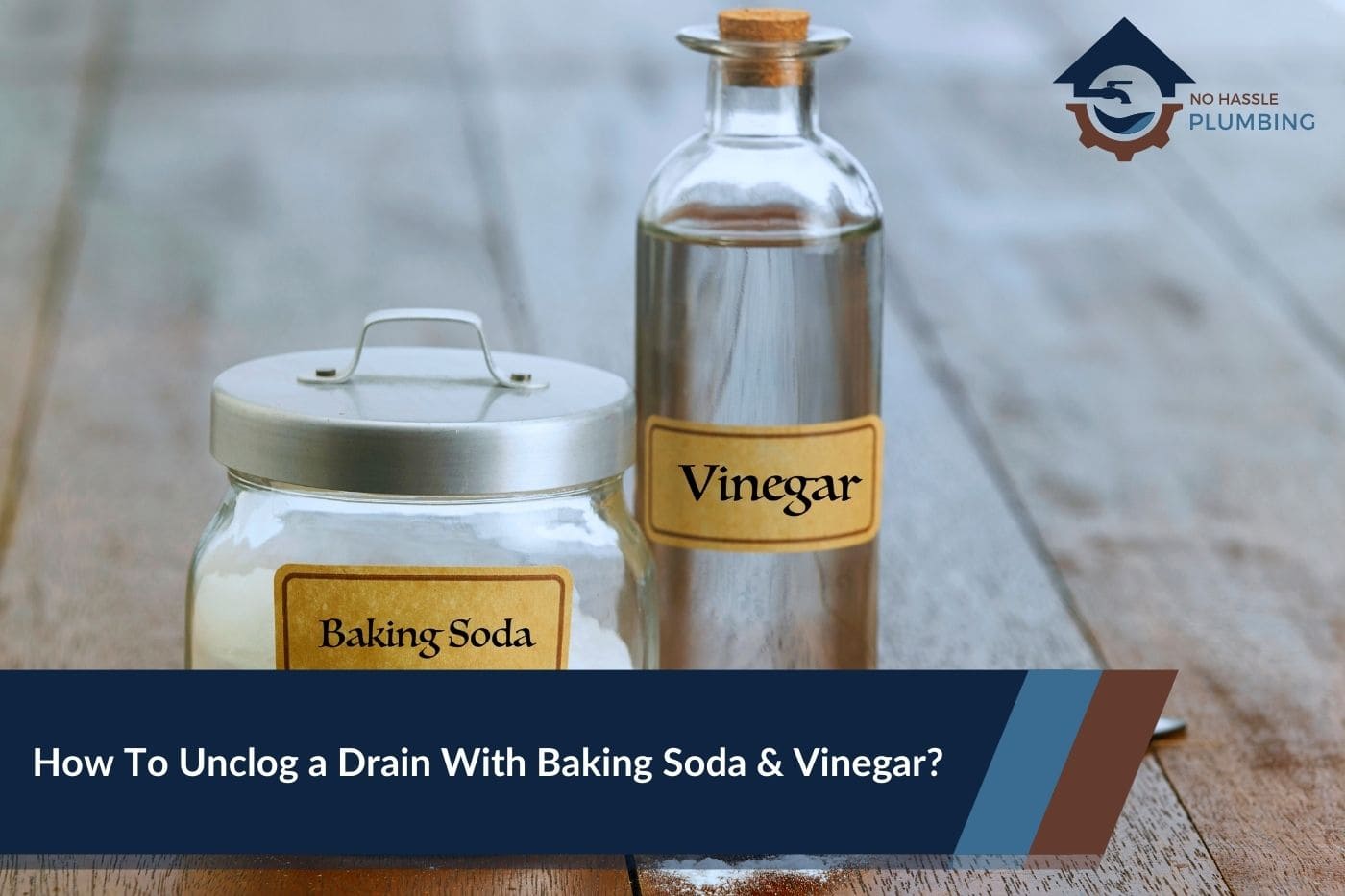Dealing with a slow-draining or clogged drain can be a real hassle, but before you reach for chemical drain cleaners or pick up the phone to call a plumber, there’s a natural and cost-effective solution you can try: unclogging your drain with baking soda and vinegar.
This DIY method can help prevent buildup in sink drains with regular cleaning, and even remove minor clogs. In this step-by-step guide, we’ll walk you through the process of using these common household ingredients to tackle various drain clogs effectively.
We will also cover the benefits and shortcomings of using baking soda and vinegar to clean drains, which alternative methods are better suited to clear the clog inside your pipes and give you some tips on how to keep your plumbing clear and running smoothly.
Contents
- Project Overview: Cleaning a Drain with Baking Soda and Vinegar
- How To Unclog a Drain with Baking Soda and Vinegar in 5 Steps
- Does Using Vinegar and Baking Soda as a Drain Cleaner Work?
- What Are The Benefits Of Cleaning Drains with Baking Soda and Vinegar?
- Are There Better Home Remedies To Clean a Clogged Drain?
- How to Keep Your Drain Clean and Prevent Clogged Plumbing?
Project Overview: Cleaning a Drain with Baking Soda and Vinegar
To unclog your drain with baking soda and vinegar begin by finding the following household items.
- One Cup of Baking Soda
- One Cup of White Vinegar
- Large Pot or Kettle
- Liquid dish Soap
- Boiling Water
- Sink Stopper
This task will typically take less than 30 minutes.
| SKILL | COST | ESTIMATED TIME |
| Low | Less than $5 | Less than 30 mins |
How To Unclog a Drain with Baking Soda and Vinegar in 5 Steps
To clean your drains with a baking soda and vinegar mixture, we perform the following actions.
- Remove any gunk from the drain.
- Pour boiling water and dish soap into the drain
- Pour baking soda into the drain opening.
- Pour vinegar down the drain.
- Flush with hot water
1. Remove Any Gunk
To clear your drain the first step is to remove any visible debris from the strainer and drain hole. Begin by removing any drain covers or stoppers from your sink or garbage disposal. Then remove any gunk such as hair or food waste with a paper towel or your hands.
2. Pour Hot Water And Dish Soap Into the Drain
Heat a pot of warm water in a tea kettle, add dish soap, and carefully pour it down the drain to help loosen up and flush away grease and oil residue. Never pour boiling water down the drain as it can damage pipes and fittings.
3. Pour Baking Soda Into The Drain
Measure out a cup of baking soda and pour it into the drain.
4. Follow With Vinegar
Measure out a cup of vinegar and pour it down the drain. Cover the drain with a stopper and let the cleaning solution sit for 5-10 minutes before removing the stopper. By this time the audible fizzing of the chemical reaction should have subsided.
5. Flush With More Hot Water
Flush out the drain by pouring more hot water down the drain. If the drain is now flowing properly, run hot water for several minutes to help flush away any remaining debris.
If the drain lines are still clogged, repeat the process with hot water and the baking soda/vinegar solution as necessary.
Does Using Vinegar and Baking Soda as a Drain Cleaner Work?
While a baking soda and vinegar solution is touted as an effective homemade method of unclogging a drain naturally, it will struggle to dislodge most fatty organic matter (FOG), solid objects, or mineral deposits.
The theory is that when you mix baking soda (sodium bicarbonate) and vinegar (acetic acid), it will create a foaming chemical reaction that gives off carbon dioxide gas. This foaming action helps to loosen dirt and debris, with the mild acidity of the vinegar able to dislodge particles, such as hair, soap scum, and grease, which may be causing the clog.
However, even with a closed system the produced gas is insufficient to move clogs and clear you drain. Additionally, while mildly acidic, the vinegar is not caustic enough to dissolve the most common causes of clogs such as oil, grease, food residue and hair.
That said, using a mix of baking soda and vinegar may help prevent drains blockages by making it part of your cleaning routine to help prevent clogs from forming.
What Are The Benefits Of Cleaning Drains with Baking Soda and Vinegar?
Using baking soda and vinegar as a drain cleaner has several benefits listed below.
- Non-toxic. Both baking powder and vinegar are natural, non-toxic substances, making them environmentally friendly, and safe to handle with no harmful fumes or chemicals.
- Cost-effective. White vinegar and baking powder are readily available and relatively inexpensive compared to common drain cleaning products.
- Gentle on pipes. Store-bought drain cleaners contain sodium hydroxide (lye) which may corrode pipes over time, our DIY drain cleaner is gentler and less likely to cause damage to your plumbing system.
- Deodorizing properties. Both are natural deodorizers and can be used as part of your routine cleaning to neutralize foul odors such as rotting food particles in garbage disposals and drains.
For best results, it is recommended to use this method as a regular maintenance routine to prevent drains from clogging.
Are There Better Home Remedies To Clean a Clogged Drain?
Several other home remedies can be used to clear a clogged drain, as given in the list below.
- Baking Soda and Salt
- Lemon Juice and baking soda
- Coke
- Boiling Water
- Physical Methods (Plunger, Auger or Clean P-Trap)
1. Baking soda & Salt
Combine baking soda and salt, then pour the mixture down the drain, followed by hot water.
2. Lemon Juice & Baking Soda
Mix baking soda with lemon juice to create a foaming solution, then pour it down the drain. In this case we are replacing the vinegar (acetic acid) with lemon juice (citric acid).
3. Coke
To clear a clogged drain with coke, pour a full can of Coca-Cola (or any other carbonated drink) down the drain and cover with a plug.
Allow it to sit for at least an hour or overnight. The carbonation and acidity will work on breaking down the clog during this time.
After the waiting period, flush the drain with hot water to help wash away the dissolved gunk.
4. Boiling water
Pouring boiling water down the drain can help to melt and dissolve grease or fatty clogs.
5. Physical Methods (Plunger, Auger, or Clean P-Trap)
When you have tough clogs, typically the only way to effectively clean them is to use a physical method to unclog them. The simplest method is to use a sink or toilet plunger to create a seal over the drain and dislodge the clog with a pumping action.
Using a drain snake can help remove a clog in hard-to-reach places, and prevent it being being pushed further down your system.
Many clogs form in the drain trap (also known as a p-trap) below your sink. This U-shaped curved pipe often collects debris. To clear out your p-trap, turn off the water supply and disconnect it from the drain and outflow pipe. Remove the p-trap and remove any trapped debris. Then reattach and check for leaks or poor drainage.
How to Keep Your Drain Clean and Prevent Clogged Plumbing?
To prevent clogs from occurring follow our advice below.
- Use drain screens or strainers to catch debris that can cause clogs.
- Avoid pouring grease or oil down the drain as these can solidify in your pipes and form a clog.
- Regularly flush your drains with hot water.
- Dispose of food scraps and coffee grounds in the trash, not the sink.
- Regularly flush your drains with hot water/dish soap or baking soda/vinegar.

